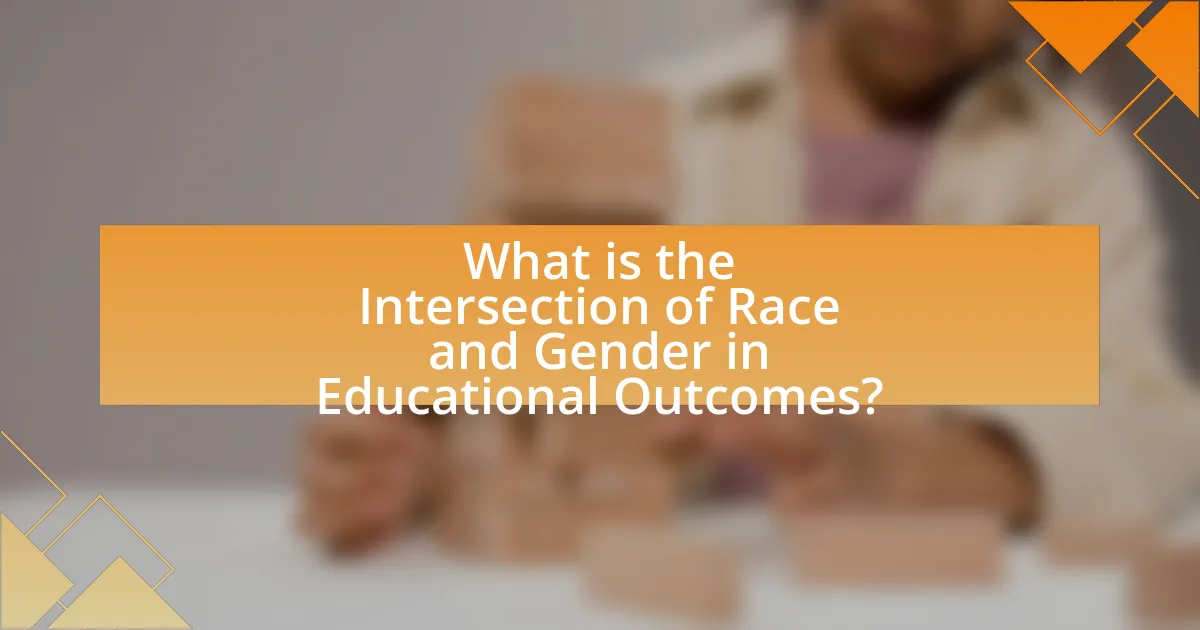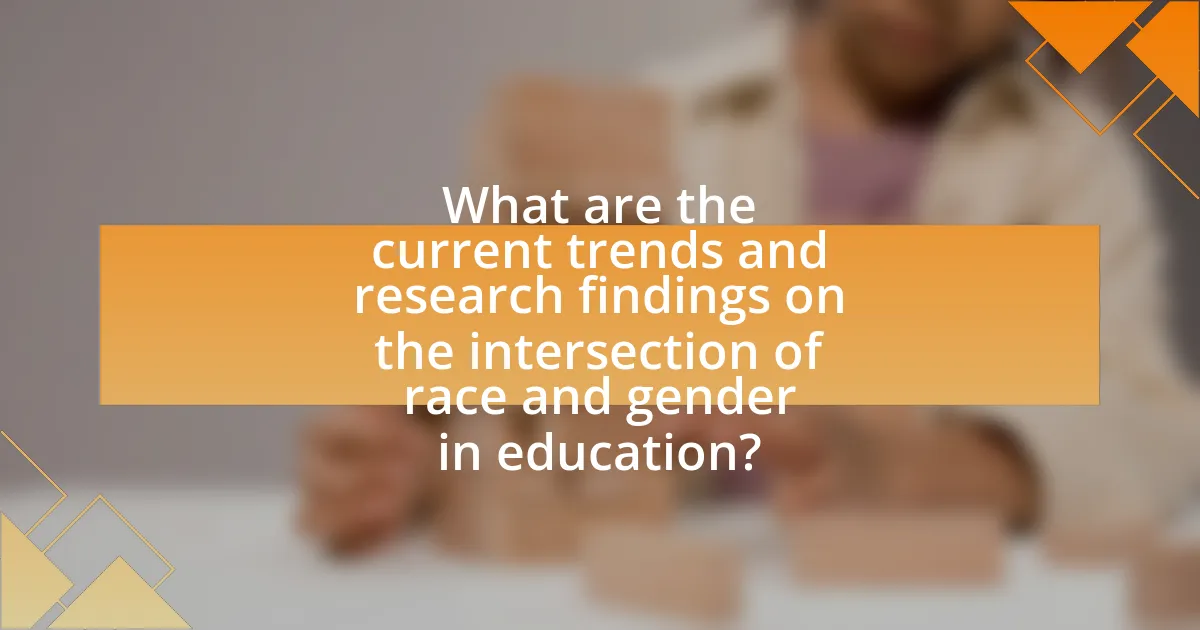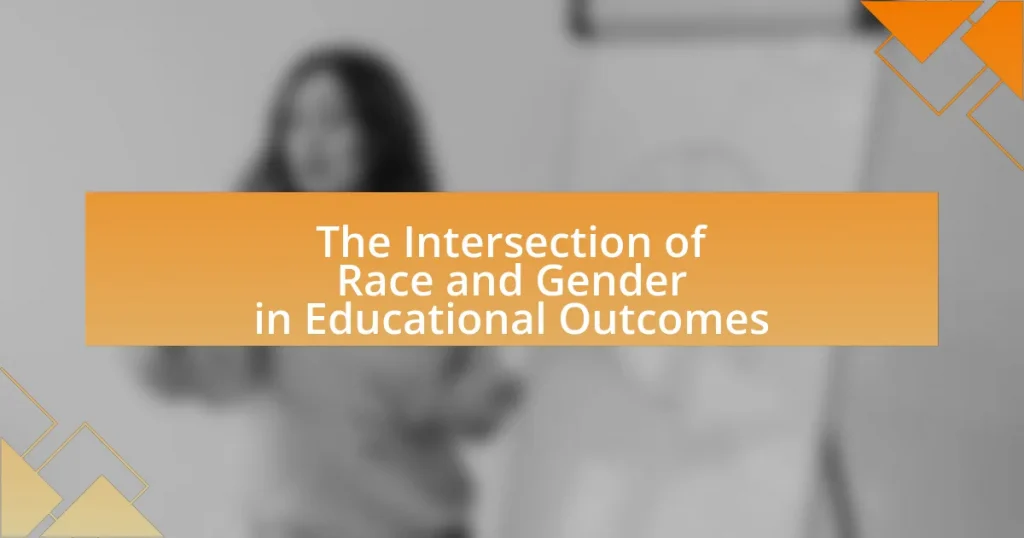The intersection of race and gender in educational outcomes highlights significant disparities in achievement and access to resources, particularly affecting Black and Hispanic girls. Research indicates that these students face compounded challenges, resulting in lower academic performance and graduation rates compared to their white peers. Systemic issues, such as implicit bias and underfunded schools, further exacerbate these inequities. The article explores the historical contexts, societal perceptions, and key factors influencing educational experiences, emphasizing the need for targeted interventions to promote equity and improve outcomes for marginalized groups. Additionally, it discusses effective teaching practices and initiatives aimed at fostering inclusive environments that support all students.

What is the Intersection of Race and Gender in Educational Outcomes?
The intersection of race and gender in educational outcomes reveals significant disparities in achievement and access to resources. Research indicates that students from marginalized racial backgrounds, particularly Black and Hispanic girls, often face compounded challenges due to both their race and gender, leading to lower academic performance and graduation rates compared to their white counterparts. For instance, a study by the National Center for Education Statistics (NCES) shows that in 2019, Black female students had a graduation rate of 62%, compared to 78% for white female students. Additionally, systemic issues such as implicit bias in disciplinary actions disproportionately affect students of color, further exacerbating educational inequities. These factors illustrate how the intersectionality of race and gender significantly influences educational outcomes, highlighting the need for targeted interventions to address these disparities.
How do race and gender influence educational experiences?
Race and gender significantly influence educational experiences by shaping access to resources, opportunities, and social dynamics within educational settings. Research indicates that students from marginalized racial backgrounds often face systemic barriers, such as lower funding for schools and implicit biases from educators, which can hinder their academic performance. For instance, a study by the National Center for Education Statistics found that Black and Hispanic students are more likely to attend underfunded schools compared to their white peers, impacting their educational outcomes.
Additionally, gender intersects with race to create unique challenges; for example, girls of color may experience both racial and gender discrimination, affecting their participation and engagement in STEM fields. According to a report by the American Association of University Women, girls of color are underrepresented in advanced math and science courses, which can limit their future career opportunities. Thus, the interplay of race and gender creates a complex landscape that shapes educational experiences and outcomes for students.
What are the historical contexts of race and gender in education?
The historical contexts of race and gender in education reveal systemic inequalities that have shaped educational access and outcomes. In the United States, for instance, the landmark Supreme Court case Brown v. Board of Education in 1954 declared racial segregation in public schools unconstitutional, highlighting the long-standing barriers faced by African American students. Additionally, the Women’s Educational Equity Act of 1974 aimed to address gender discrimination in education, recognizing that women and girls faced significant obstacles in accessing equal educational opportunities. These legislative milestones illustrate the ongoing struggle against racial and gender disparities, with statistics showing that historically marginalized groups continue to experience lower graduation rates and limited access to advanced coursework compared to their white male counterparts.
How do societal perceptions of race and gender shape educational policies?
Societal perceptions of race and gender significantly shape educational policies by influencing the priorities and frameworks within which these policies are developed. For instance, research indicates that biases regarding race and gender can lead to disparities in funding, curriculum design, and disciplinary practices in schools. A study by the National Center for Education Statistics (NCES) found that schools in predominantly minority neighborhoods often receive less funding, which directly impacts educational resources and opportunities available to students. Additionally, gender stereotypes can affect the representation of women and minorities in STEM fields, leading to policies that may inadvertently perpetuate these gaps. Thus, societal views on race and gender not only inform the creation of educational policies but also determine their effectiveness and equity in practice.
Why is it important to study the intersection of race and gender in education?
Studying the intersection of race and gender in education is crucial because it reveals how these identities shape educational experiences and outcomes. Research indicates that students from marginalized racial and gender backgrounds often face systemic barriers that affect their academic performance and access to resources. For instance, a study by the American Educational Research Association found that Black girls are disproportionately subjected to disciplinary actions in schools, which negatively impacts their educational attainment. Understanding these dynamics allows educators and policymakers to develop targeted interventions that promote equity and improve educational outcomes for all students.
What implications does this intersection have for educational equity?
The intersection of race and gender significantly impacts educational equity by perpetuating disparities in access, resources, and outcomes for marginalized groups. Research indicates that students who belong to both racial minorities and specific gender identities often face compounded disadvantages, leading to lower academic achievement and higher dropout rates. For instance, a study by the National Center for Education Statistics found that Black and Hispanic girls experience higher rates of suspension and expulsion compared to their white counterparts, which adversely affects their educational trajectories. This intersectionality highlights the need for targeted interventions that address both racial and gender biases to promote equitable educational opportunities for all students.
How can understanding this intersection inform teaching practices?
Understanding the intersection of race and gender can inform teaching practices by enabling educators to create more inclusive and equitable learning environments. Research indicates that students from marginalized racial and gender backgrounds often face systemic biases that affect their educational outcomes. For instance, a study by the American Educational Research Association found that Black girls are often perceived as less capable than their white peers, which can lead to lower expectations from teachers and reduced academic support. By recognizing these biases, educators can implement culturally responsive teaching strategies, such as differentiated instruction and inclusive curriculum design, that address the specific needs of diverse student populations. This approach not only fosters a sense of belonging but also enhances academic achievement among all students, thereby promoting equity in educational outcomes.

What are the key factors affecting educational outcomes at the intersection of race and gender?
Key factors affecting educational outcomes at the intersection of race and gender include socioeconomic status, access to quality educational resources, and systemic biases within educational institutions. Socioeconomic status significantly influences educational opportunities, as students from lower-income backgrounds often attend underfunded schools, which impacts their academic performance. Access to quality educational resources, such as experienced teachers and advanced coursework, varies by race and gender, leading to disparities in achievement. Systemic biases, including stereotypes and discrimination, can adversely affect the expectations educators have for students based on their race and gender, further influencing educational outcomes. Research by the National Center for Education Statistics shows that Black and Hispanic students, particularly females, face unique challenges that hinder their academic success compared to their white counterparts.
How do socioeconomic status and access to resources play a role?
Socioeconomic status significantly influences educational outcomes by determining access to resources such as quality schools, extracurricular activities, and educational materials. Students from higher socioeconomic backgrounds typically have better access to these resources, which enhances their academic performance and opportunities for advancement. For instance, research from the National Center for Education Statistics indicates that students from low-income families are less likely to have access to advanced coursework and experienced teachers, leading to disparities in educational attainment. Additionally, access to technology and tutoring services is often limited for those in lower socioeconomic brackets, further exacerbating educational inequalities.
What disparities exist in funding and resource allocation?
Disparities in funding and resource allocation significantly affect educational outcomes, particularly among marginalized groups. Research indicates that schools in predominantly Black and Hispanic neighborhoods receive substantially less funding than those in predominantly white areas, with a 2019 report from the Education Trust highlighting that schools serving students of color receive about $23 billion less in funding annually compared to their white counterparts. Additionally, resource allocation often favors affluent districts, leading to inequities in access to advanced coursework, experienced teachers, and essential educational materials. This systemic underfunding perpetuates achievement gaps, as students in underfunded schools face barriers that hinder their academic success.
How does family background influence educational attainment?
Family background significantly influences educational attainment by shaping access to resources, expectations, and support systems. Children from families with higher socioeconomic status often have access to better educational resources, such as quality schools, tutoring, and extracurricular activities, which enhance learning opportunities. Research indicates that parental education levels correlate with children’s academic performance; for instance, a study by the National Center for Education Statistics found that students whose parents have higher education levels tend to achieve higher academic outcomes. Additionally, family expectations and cultural values regarding education can motivate children to pursue higher education, further impacting their educational attainment.
What role do cultural attitudes and biases play in educational settings?
Cultural attitudes and biases significantly influence educational settings by shaping student interactions, teacher expectations, and curriculum design. These biases can lead to disparities in academic achievement and access to resources, often disadvantaging students from marginalized backgrounds. For instance, research by the American Psychological Association indicates that implicit biases among educators can result in lower expectations for students of color, which negatively impacts their academic performance and engagement. Additionally, cultural attitudes can affect the inclusivity of the curriculum, often sidelining diverse perspectives and reinforcing stereotypes. This interplay of cultural attitudes and biases ultimately contributes to unequal educational outcomes, highlighting the need for awareness and intervention in educational practices.
How do implicit biases affect teacher expectations and student performance?
Implicit biases significantly influence teacher expectations and, consequently, student performance. Research indicates that teachers may unconsciously hold lower expectations for students from marginalized racial and gender groups, which can lead to a self-fulfilling prophecy where these students perform below their potential. For instance, a study by Tenenbaum and Ruck (2007) found that teachers were more likely to perceive Black students as less capable than their White peers, impacting the quality of feedback and support provided. This differential treatment can hinder academic achievement and perpetuate educational disparities, illustrating the critical role of implicit biases in shaping educational outcomes.
What impact do peer relationships have on educational outcomes?
Peer relationships significantly influence educational outcomes by affecting students’ motivation, engagement, and academic performance. Positive peer interactions can enhance learning experiences, as students often collaborate, share knowledge, and support each other academically. Research indicates that students with strong peer relationships tend to have higher grades and better attendance rates. For instance, a study published in the Journal of Educational Psychology found that students who reported having supportive friends were more likely to achieve higher academic success, demonstrating the critical role of social connections in education.

What are the current trends and research findings on the intersection of race and gender in education?
Current trends and research findings indicate that the intersection of race and gender significantly influences educational outcomes, with disparities evident in academic achievement, disciplinary actions, and access to advanced coursework. For instance, studies show that Black and Latina girls face unique challenges, often experiencing both racial and gender biases that affect their educational experiences and opportunities. Research published in the “Journal of Educational Psychology” by authors such as Michelle M. Fine and others highlights that these students are more likely to be subjected to harsher disciplinary measures compared to their white counterparts, which negatively impacts their academic performance and engagement. Additionally, the “National Center for Education Statistics” reports that while girls generally outperform boys in reading, boys of color lag behind in both reading and math proficiency, illustrating the compounded effects of race and gender on educational achievement. These findings underscore the necessity for targeted interventions that address the specific needs of students at this intersection.
What recent studies highlight disparities in educational outcomes?
Recent studies highlight significant disparities in educational outcomes based on race and gender. For instance, a 2022 report by the National Center for Education Statistics found that Black and Hispanic students consistently score lower on standardized tests compared to their White and Asian peers, with a notable achievement gap in mathematics and reading proficiency. Additionally, research published in the Journal of Educational Psychology in 2023 indicated that female students of color face unique challenges, including lower teacher expectations and fewer advanced placement opportunities, which further exacerbate educational inequities. These findings underscore the persistent impact of systemic factors on the educational experiences of marginalized groups.
How do these studies measure the impact of race and gender?
Studies measure the impact of race and gender through quantitative analysis, qualitative assessments, and comparative frameworks. Quantitative methods often involve statistical techniques, such as regression analysis, to evaluate educational outcomes across different racial and gender groups, allowing researchers to identify disparities in achievement, enrollment, and graduation rates. For instance, the National Center for Education Statistics provides data that reveals significant gaps in performance between racial groups, highlighting how these factors intersect with gender. Qualitative assessments, such as interviews and focus groups, explore personal experiences and perceptions related to race and gender in educational settings, providing context to the numerical data. Additionally, comparative frameworks analyze the intersectionality of race and gender by examining how these identities collectively influence educational experiences and outcomes, as seen in studies like “The Impact of Race and Gender on Educational Outcomes” published in the Journal of Educational Psychology.
What are the key findings regarding achievement gaps?
Key findings regarding achievement gaps indicate that significant disparities exist in educational outcomes based on race and gender. Research shows that students from marginalized racial and ethnic backgrounds, particularly Black and Hispanic students, consistently perform lower on standardized tests compared to their White and Asian peers. For instance, the National Assessment of Educational Progress (NAEP) reports that in 2019, Black students scored an average of 26 points lower in math and 24 points lower in reading than White students in fourth grade. Additionally, gender differences reveal that while girls outperform boys in reading, boys tend to excel in math, contributing to a complex interplay of factors influencing achievement gaps. These findings underscore the need for targeted interventions to address the systemic inequities affecting educational performance across different demographics.
How are educational institutions addressing these disparities?
Educational institutions are addressing disparities in educational outcomes related to race and gender through targeted programs and policies. These initiatives include implementing diversity training for faculty, developing mentorship programs for underrepresented students, and revising curricula to be more inclusive. For example, many universities have established offices dedicated to diversity and inclusion, which focus on creating equitable learning environments and providing resources for marginalized groups. Research indicates that institutions that actively promote inclusive practices see improved academic performance and retention rates among diverse student populations, demonstrating the effectiveness of these approaches.
What programs and initiatives are being implemented to promote equity?
Programs and initiatives being implemented to promote equity in education include targeted scholarship programs, mentorship initiatives, and diversity training for educators. For instance, the Gates Millennium Scholars Program provides scholarships to underrepresented minority students, aiming to increase their access to higher education. Additionally, mentorship programs like the Black Girls Code initiative focus on empowering young girls of color in technology fields, fostering both academic and professional growth. Furthermore, many school districts are adopting diversity training for teachers to address implicit biases and create inclusive classroom environments, which is supported by research indicating that such training can improve educational outcomes for marginalized groups.
How effective are these interventions in improving outcomes?
Interventions aimed at addressing the intersection of race and gender in educational outcomes are effective in improving student performance and equity. Research indicates that targeted programs, such as mentorship and culturally relevant pedagogy, significantly enhance academic achievement among marginalized groups. For instance, a study by the National Bureau of Economic Research found that mentorship programs increased college enrollment rates for underrepresented minorities by 20%. Additionally, implementing inclusive curricula has been shown to boost engagement and retention rates among female students of color, further demonstrating the positive impact of these interventions on educational outcomes.
What practical strategies can educators use to support all students?
Educators can support all students by implementing differentiated instruction, which tailors teaching methods to meet diverse learning needs. This approach allows educators to address varying abilities, learning styles, and cultural backgrounds within the classroom. Research indicates that differentiated instruction can lead to improved academic outcomes, particularly for marginalized groups. For instance, a study by Tomlinson (2001) in “How to Differentiate Instruction in Mixed-Ability Classrooms” shows that students in differentiated environments demonstrate higher engagement and achievement levels. Additionally, incorporating culturally responsive teaching practices fosters an inclusive atmosphere, enhancing students’ sense of belonging and motivation.
How can culturally responsive teaching improve educational outcomes?
Culturally responsive teaching can improve educational outcomes by fostering an inclusive learning environment that acknowledges and values students’ diverse cultural backgrounds. This approach enhances student engagement and motivation, leading to higher academic achievement. Research indicates that when educators incorporate culturally relevant materials and teaching methods, students from various racial and ethnic backgrounds demonstrate improved performance and lower dropout rates. For instance, a study by Gay (2010) highlights that culturally responsive pedagogy positively impacts students’ self-esteem and academic success, particularly among marginalized groups. By aligning teaching practices with students’ cultural contexts, educators can create a more equitable educational landscape that supports all learners.
What best practices can educators adopt to foster an inclusive environment?
Educators can adopt several best practices to foster an inclusive environment, including implementing culturally responsive teaching, promoting diverse curricula, and encouraging open dialogue about race and gender. Culturally responsive teaching involves recognizing and incorporating students’ cultural backgrounds into the learning process, which has been shown to improve engagement and academic performance among diverse student populations. Research indicates that diverse curricula, which reflect a variety of perspectives and experiences, can enhance students’ understanding and appreciation of different cultures, thereby fostering a more inclusive atmosphere. Additionally, creating safe spaces for open dialogue allows students to express their thoughts and experiences related to race and gender, promoting empathy and understanding among peers. These practices collectively contribute to a more equitable educational environment, addressing disparities in educational outcomes linked to race and gender.



